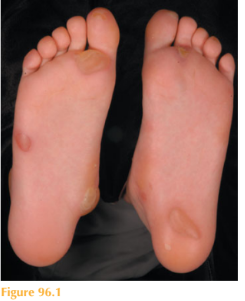History
A 14-year-old boy attends the dermatology out-patient clinic with his mother. He is increasingly troubled by blisters. The blisters affect the plantar surfaces of his feet, particularly the heel, below the metatarsal heads and toes. They have also occurred on his fingers following an exam last year, and a recent school ski-trip provoked blisters over his shins. The appearance of blisters on his feet is directly related to activity and they occur with relatively less activity in summer.
He is otherwise well and not on medication. His mother and one of his two older sisters also suffer with blisters. They have only experienced plantar blisters, and comment that new shoes or walking further than 1.6 km can provoke blisters. They limit their activity and the types of footwear accordingly. None of the family was affected with blisters at birth.
Examination
There is nothing abnormal to find on full examination except for several tense non-inflammatory blisters in an asymmetrical distribution over the weight-bearing aspects of the plantar surface of both feet (Fig. 96.1). He has no skin lesions elsewhere.

Questions
• What is the diagnosis?
• What investigations can you perform to confirm the diagnosis?
• How would you manage this patient?
The patient gives a story which is suggestive of a mechano-bullous skin disorder (blisters due to skin fragility occurring at sites of friction). The positive family history supports an autosomal dominant pattern of inheritance. Apparent onset around adolescence is not unusual and often relates to growth, weight gain and increased physical activity. This patient’s history is typical of epidermolysis bullosa (EB) simplex with a localized distribu-tion (also referred to as Webber–Cockayne syndrome). EB simplex is a group of disorders characterized by intra-epidermal blistering. The disease phenotype can range from mild to severe. The mildest and most common form is EB simplex localized. Although it can present in infancy or childhood, presentation in adult- hood or even non-presentation (such as the patient’s mother and sister) is not uncommon.
Blistering is worse in warm weather as sweat increases friction in footwear. Biopsy of affected skin is not performed, as the plantar surface of the feet heals poorly. Gently rubbing an unaffected area of non-plantar skin for a biopsy can produce a subclinical blister which will demonstrate the ultrastructural basis of skin fragility. Demonstration of a pathogenic mutation within Keratin5 or Keratin14 will confirm the diagnosis.
The management of EB simplex is:
1. avoidance of new blisters by reducing sweat and minimizing friction within footwear, as well as practical and supportive advice around school, work and leisure activities;
2. ‘popping’ blisters using aseptic methods to relieve pressure and pain and prevention of infection within blisters and erosions, with special dressings which can be removed without trauma to the skin;
3. treatment of callosities which form around areas of frequent blistering, but can act as foci for the development of new blisters;
4. offering adequate and targeted pain control for episodes of blisters as well as chronic neuropathic pain; and
5. genetic counselling.
KEY POINTS
• There are different forms of epidermolysis bullosa with site and severity of blistering varying according to the molecular defect.
• EB simplex localized is due to dominant negative mutation of either Keratin 5 or 14 (autosomal dominant pattern of inheritance).
• Practical advice around reducing blistering, blister management and pain control are the cornerstones of management.
need an explanation for this answer? contact us directly to get an explanation for this answer